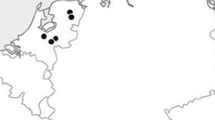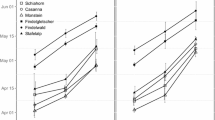Abstract
Under climate warming, plants will undergo novel selective pressures to adjust reproductive timing. Adjustment between reproductive phenology and environment is expected to be higher in arctic and alpine habitats because the growing season is considerably short. As early- and late-flowering species reproduce under very different environmental conditions, selective pressures on flowering phenology and potential effects of climate change are likely to differ between them. However, there is no agreement on the magnitude of the benefits and costs of early- vs. late-flowering species under a global warming scenario. In spite of its relevance, phenotypic selection on flowering phenology has rarely been explored in alpine plants and never in Mediterranean high mountain species, where selective pressures are very different due to the summer drought imposed over the short growth season. We hypothesized that late-flowering plants in Mediterranean mountains should present stronger selective pressures towards early onset of reproduction than early-flowering species, because less water is available in the soil as growing season progresses. We performed selection analyses on flowering onset and duration in two high mountain species of contrasting phenology. Since phenotypic selection can be highly context-dependent, we studied several populations of each species for 2 years, covering their local altitudinal ranges and their different microhabitats. Surrogates of biotic selective agents, like fruitset for pollinators and flower and fruit loss for flower and seed predators, were included in the analysis. Differences between the early- and the late-flowering species were less than expected. A consistent negative correlational selection of flowering onset and duration was found affecting plant fitness, i.e., plants that bloomed earlier flowered for longer periods improving plant fitness. Nevertheless, the late-flowering species may experience higher risks under climate warming because in extremely warm and dry years the earlier season does not bring about a longer flowering duration due to summer drought.


Similar content being viewed by others
References
Alatalo JM, Totland Ø (2003) Response to simulated climatic change in an alpine and subarctic pollen-risk strategist, Silene acaulis. Glob Change Biol 3:74–79
Albert MJ, Iriondo JM, Escudero A et al (2008) Dissecting components of flowering pattern: size effects on female fitness. Bot J Linn Soc 156:227–236
Arbuckle J (2003) Amos 5 user’s guide supplement. AMOS Development Corporation, Spring House, PA
Arnold SJ, Wade MJ (1984a) On the measurement of natural and sexual selection: Applications. Evolution 38:720–734
Arnold SJ, Wade MJ (1984b) On the measurement of natural and sexual selection: Theory. Evolution 38:709–719
Beniston M, Diaz HF, Bradley RS (1997) Climatic change at high elevation sites: an overview. Clim Change 36:233–251
Bradshaw WE, Holzapfel CM (2006) Evolutionary response to rapid climate change. Science 312:1477–1478
Brody AK (1997) Effects of pollinators, herbivores and seed predators on flowering phenology. Ecology 78:1624–1631
Burgess KS, Etterson JR, Galloway LF (2007) Artificial selection shifts flowering phenology and other correlated traits in an autotetraploid herb. Heredity 99:641–648
Conner JK (1996) Understanding natural selection: an approach integrating selection gradients, multiplicative fitness components, and path analysis. Ethol Ecol Evol 8:387–397
Donnison IS, Francis D (1994) Experimental control of floral reversion in isolated shoot apices of the long-day plant Silene coeli-rosa. Physiol Plant 92:329–335
Donohue K (2005) Niche construction through phenological plasticity: life history dynamics and ecological consequences. New Phytol 166:83–92
Dunne JA, Harte J, Taylor KJ (2003) Subalpine meadow flowering phenology responses to climate change: integrating experimental and gradient methods. Ecol Monogr 73:69–86
Dye DG (2002) Variability and trends in the annual snow cover cycle in Northern Hemisphere land areas, 1972–2000. Hydrol Proc 16:3065–3077
Ehrlén J, Münzbergová Z (2009) Timing of flowering: Opposed selection on different fitness components and trait covariation. Am Nat 173:819–830
Elzinga JA, Atlan A, Biere A et al (2007) Time after time: flowering phenology and biotic interactions. Trends Ecol Evol 22:432–439
Galen C, Stanton ML (1993) Short-term responses of alpine buttercups to experimental manipulations of growing season length. Ecology 74:1052–1058
Galen C, Stanton ML (1995) Responses of snowbed plant species to changes in growing season length. Ecology 76:1546–1557
García-Camacho R, Escudero A (2009) Reproduction of an early-flowering Mediterranean mountain narrow endemic (Armeria caespitosa) in a contracting mountain island. Plant Biol 11:515–525
García-Camacho R, Méndez M, Escudero A (2009) Pollination context effects in the high-mountain dimorphic Armeria caespitosa (Plumbaginaceae): neighborhood is something more than density. Am J Bot 96:1620–1626
Giménez-Benavides L, Dötterl S, Jürgens A et al (2007a) Generalist diurnal pollination provides greater fitness in a plant with nocturnal pollination syndrome: assessing the effects of a Silene-Hadena interaction. Oikos 116:1461–1472
Giménez-Benavides L, Escudero A, Iriondo JM (2007b) Reproductive limits of a late-flowering high-mountain Mediterranean plant along an elevational climate gradient. New Phytol 173:367–382
Giménez-Benavides L, Escudero A, Iriondo JM (2007c) Local adaptation enhances seedling recruitment along an altitudinal gradient in a high mountain Mediterranean plant. Ann Bot 99:723–734
Giménez-Benavides L, Escudero A, Iriondo JM (2008) What shapes the altitudinal range of a high mountain Mediterranean plant? Recruitment probabilities from ovule to seedling stage. Ecography 31:731–740
Giménez-Benavides L, Albert MJ, Iriondo JM et al. (2010) Demographic processes of upward range contraction in a long-lived Mediterranean high mountain plant. Ecography (in press)
Gómez JM (2008) Sequential conflicting selection due to multispecific interactions triggers evolutionary trade-offs in a monocarpic herb. Evolution 62:668–679
Gómez JM, Zamora R (2000) Spatial variation in the selective scenarios of Hormathophylla spinosa (Cruciferae). Am Nat 155:657–668
Gómez JM, Perfectti F, Bosch J et al (2009) A geographic selection mosaic in a generalized plant-pollinator-herbivore system. Ecol Monogr 79:245–263
Grabherr G, Gottfried M, Pauli H (1994) Climate effects on mountain plants. Nature 369:448
Grace JB (2006) Structural equation modeling and natural systems. Cambridge University Press, Cambridge
Hegland SJ, Nielsen A, Lázaro A et al (2009) How does global warming affect plant-pollinator interactions? Ecol Lett 12:184–195
Henning Olson U, Foss T, Troye SW et al (2000) The performance of ML, GLS, and WLS estimation in structural equation modeling under conditions of misspecification and nonnormality. Struct Equ Model 7:557–595
Inouye D (2008) Effects of climate change on phenology, frost damage and floral abundance of montane wildflowers. Ecology 89:353–362
Inouye DW, Morales MA, Dodge GJ (2002) Variation in timing and abundance of flowering by Delphinium barbeyi Huth (Ranunculaceae), the roles of snowpack, frost and La Niña, in the context of climate change. Oecologia 130:543–550
Jump AS, Peñuelas J (2005) Running to stand still: adaptation and the response of plants to rapid climate change. Ecol Lett 8:1010–1020
Kelly AE, Goulden ML (2008) Rapid shifts in plant distribution with recent climate change. Proc Natl Acad Sci USA 105:11823–11826
Klanderud K, Birks HJ (2003) Recent increases in species richness and shifts in altitudinal distributions of Norwegian mountain plants. Holocene 13:1–6
Koenig WD, Albano SS, Dickinson JL (1991) A comparison of methods to partition selection acting via components of fitness: do larger male bullfrogs have greater hatching success? J Evol Biol 4:309–320
Körner C (2007) The use of ‘altitude’ in ecological research. Trends Ecol Evol 22:569–574
Kudo G (1991) Effects of snow-free period on the phenology of alpine plants inhabiting snow patches. Arct Antarct Alp Res 23:436–443
Kudo G (1993) Relationship between flowering time and fruit set of the entomophilous alpine shrub, Rhododendron aureum (Ericaceae), inhabiting snow patches. Am J Bot 80:1300–1304
Kudo G, Hirao AS (2006) Habitat-specific responses in the flowering phenology and seed set of alpine plants to climate variation: implications for global-change impacts. Popul Ecol 48:49–58
Lande R, Arnold SJ (1983) The measurement of selection on correlated characters. Evolution 37:1210–1226
Lang A (1957) The effect of gibberellin upon flower formation. Proc Natl Acad Sci USA 43:709–717
Molau U (1993) Relationships between flowering phenology and life-history strategies in tundra plants. Arct Alp Res 25:391–402
Molau U, Nordenhall U, Eriksen B (2005) Onset of flowering and climate variability in an alpine landscape: A 10-year study from Swedish Lapland. Am J Bot 92:422–431
Nogués-Bravo D, Araújo MB, Martinez-Rica JP et al (2007) Exposure of global mountain systems to climate change during the 21st century. Glob Environ Change 17:420–428
Nogués-Bravo D, Araújo MB, Lasanta T et al (2008) Climate change in Mediterranean mountains during the XXIst century. Ambio 37:380–385
Pilson D (2000) Herbivory and natural selection on flowering phenology in wild sunflower, Helianthus annuus. Oecologia 122:72–82
Price MV, Waser NM (1998) Effects of experimental warming on plant reproductive phenology in a subalpine meadow. Ecology 79:1261–1271
Sandring S, Ågren J (2009) Pollinator-mediated selection on floral display and flowering time in the perennial herb Arabidopsis lyrata. Evolution 63:1292–1300
Sandring S, Riihimäki M, Savolainen O et al (2007) Selection on flowering time and floral display in an alpine and a lowland population of Arabidopsis lyrata. J Evol Biol 20:558–567
SAS Institute Inc (1996) SAS/STAT software: changes and enhancements through release 6.11. Cary, NC
Schär C, Vidale PL, Luthi et al (2004) The role of increasing temperature variability in European summer heatwaves. Nature 427:332–336
Scheiner SM, Mitchell RJ, Calahan HS (2000) Using path analysis to measure natural selection. J Evol Biol 13:423–433
Shipley B (2000) Cause and correlation in biology. Cambridge University Press, Cambridge
Stanton ML, Roy BA, Thiede DA (2000) Evolution in stressful environments. I. Phenotypic variability, phenotypic selection and response to selection in five distinct environmental stresses. Evolution 54:93–111
Stenström M, Molau U (1992) Reproductive ecology of Saxifraga oppositifolia: phenology, mating system and reproductive success. Arct Antarct Alp Res 24:337–343
Stinson KA (2004) Natural selection favors rapid reproductive phenology in Potentilla pulcherrima (Rosaceae) at opposite ends of a subalpine snowmelt gradient. Am J Bot 91:531–539
Talon M, Zeewaart JAD (1990) Gibberelins and stem growth as related to photoperiod in Silene armeria L. Plant Physiol 92:1094–1100
R Development Core Team (2010) R: A Language and Environment for Statistical Computing. R Foundation for Statistical Computing Vienna, Austria. Available from http://www.R-project.org (Accessed July 2010)
Theurillat JP, Guisan A (2001) Potential impact of climate change on vegetation in the European Alps: a review. Clim Change 50:77–109
Thuiller W, Lavorel S, Araújo MB et al (2005) Climate change threats to plant diversity in Europe. Proc Natl Acad Sci USA 102:8245–8250
Totland Ø (1994) Intraseasonal variation in pollination intensity and seed set in an alpine population of Ranunculus acris in southwestern Norway. Ecography 17:159–165
Totland Ø (1997) Effects of flowering time and temperature on growth and reproduction in Leontodon autumnalis var. taraxaci a late-flowering alpine plant. Arct Alp Res 29:285–290
Totland Ø (1999) Effects of temperature on performance and phenotypic selection on plant traits in alpine Ranunculus acris. Oecologia 120:242–252
Totland Ø (2001) Environment-dependent pollen limitation and selection on floral traits in an alpine species. Ecology 82:2233–2244
Wade MJ, Kalisz S (1989) The additive partitioning of selection gradients. Evolution 43:1567–1569
Acknowledgments
The authors thank the staff of Parque Natural de las Cumbres, Circo y Lagunas de Peñalara for permission to work in the area and C. F. Aragón, A. L. Luzuriaga and M. J. Albert for helping with field work. The authors also thank D. Palacios for providing the digital images for snowmelt date estimation, K. Donohue and M. de la Cruz for providing SAS and R scripts, respectively, and L. De Hond for linguistic assistance. This work was supported by projects ISLAS (CGL2009-13190-C03-01), SIL-HAD (CGL2009-08755) and LIMITES (CGL2009-07229) funded by the Ministerio de Ciencia e Innovación (Spain) and REMEDINAL2 funded by the Comunidad de Madrid.
Author information
Authors and Affiliations
Corresponding author
Electronic supplementary material
Below is the link to the electronic supplementary material.
Rights and permissions
About this article
Cite this article
Giménez-Benavides, L., García-Camacho, R., Iriondo, J.M. et al. Selection on flowering time in Mediterranean high-mountain plants under global warming. Evol Ecol 25, 777–794 (2011). https://doi.org/10.1007/s10682-010-9440-z
Received:
Accepted:
Published:
Issue Date:
DOI: https://doi.org/10.1007/s10682-010-9440-z




